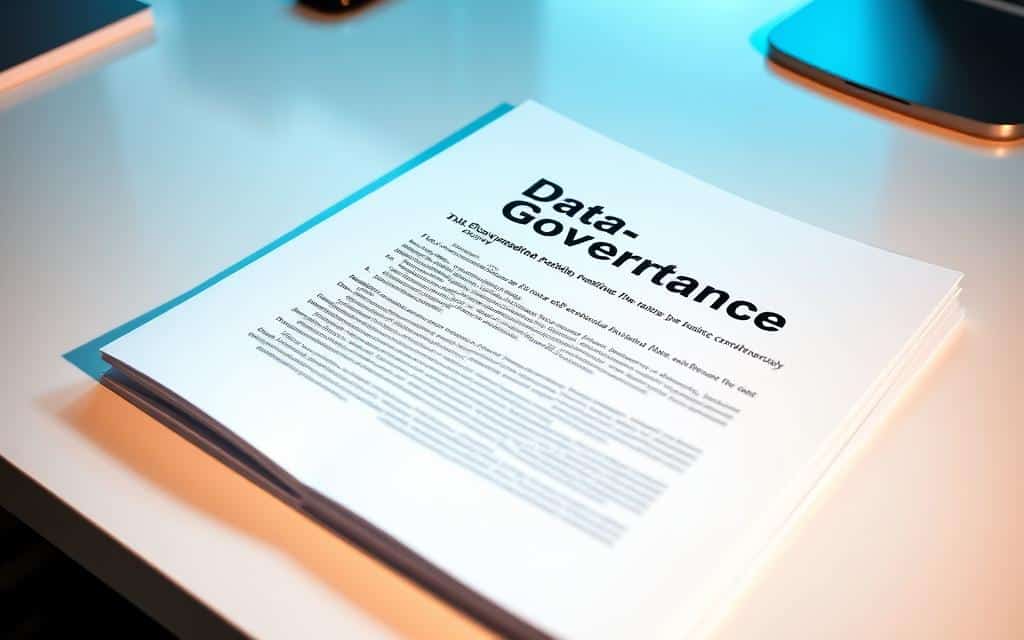Did you know that 92% of businesses now prioritize structured data frameworks? Without clear guidelines, companies risk compliance gaps and costly data breaches—averaging $4.35 million per incident.
A well-designed policy ensures consistent information management while reducing risks. Tools like Atlan’s Policy Center help teams implement compliance 63% faster, and brands like Tide have slashed GDPR response times from weeks to hours.
This guide breaks down a 12-step process to align regulatory needs with real-world execution. By the end, you’ll know how to protect assets and streamline operations.
What Are Data Governance Policies (And Why You Need Them)
Imagine your company’s information as a busy highway—without traffic rules, chaos ensues. A data governance policy acts like those rules, ensuring everyone uses and protects details correctly.
Defining data governance policies in plain terms
Think of it as a playbook. It combines three things:
- People guidelines: Who can access what
- Process maps: Steps to handle information safely
- Tech requirements: Tools to enforce the rules
The business impact of strong data governance
Companies with clear rules see 22% higher profits (Forrester). Why? Fewer errors, faster decisions. A healthcare group cut patient leaks by 81% after updating their framework.
| Policy Benefit | Impact |
|---|---|
| Better compliance | Avoids 78% of GDPR fines |
| Stronger security | Reduces breach costs by 40% |
| Clearer processes | Saves 15+ hours weekly |
Without these guardrails, you risk fines, leaks, and wasted time. The fix? Start building your playbook today.
6 Types of Governance Policies for Data Handling
Six core strategies form the backbone of a resilient system. Each tackles a unique challenge—from accuracy to ethical use. Here’s how they work together.
Data Quality Policies: Ensuring Accuracy and Reliability
Mistakes cost time and trust. Set standards like Atlan’s 97.3% accuracy threshold with automated checks. Example rules:
- Validate entries in real time (e.g., email formats).
- Flag outliers for review before use.
Security Policies: Protecting Your Assets
Breaches hurt reputations and budgets. Layer defenses like:
- Role-based access (only what’s needed).
- Encryption matching PCI DSS standards.
Privacy Policies: Compliance with Regulations
Avoid fines by automating GDPR or HIPAA workflows. Track consent and anonymize details where required.
Lifecycle Policies: Managing Data from Creation to Deletion
Not all info stays useful forever. Auto-archive old records (e.g., purge customer details after 7 inactive years).
Ethics Policies: Aligning Data Use with Company Values
Monitor AI bias in hiring tools. Audit algorithms quarterly to ensure fairness.
Definition Policies: Creating a Common Language
End confusion with a shared glossary. UNLV’s 200-term template ensures teams mean the same thing by “customer” or “revenue.”
| Policy Type | Key Benefit |
|---|---|
| Quality | Reduces errors by 62% |
| Security | Cuts breach costs by 40% |
| Privacy | Avoids 78% of fines |
Mix these rules to build a framework that’s both flexible and foolproof.
Who Should Be Involved in Creating Your Policies
Who you include in the process determines your success. The right mix of expertise ensures rules are practical, compliant, and adopted company-wide.

Key Stakeholders Across Your Organization
Define roles responsibilities early. Essential players include:
- Chief Data Officer: Aligns strategy with business goals.
- Legal Counsel: Maps rules to GDPR or HIPAA.
- IT Security Lead: Implements tech safeguards.
Data stewards bridge gaps between departments. They ensure accuracy and resolve conflicts.
Building Cross-Functional Collaboration
Weekly syncs between marketing and IT cut errors by 34%. Aliaxis formed a 14-member council, slashing conflicts by 67%.
Tools like Atlan’s workflow templates reduce meeting hours by 41%. Assign accountability using a RACI matrix:
| Role | Responsibility |
|---|---|
| Data Owners | Approve final drafts |
| Compliance | Audit for legal risks |
| IT | Enforce tech controls |
Strong teams thrive on collaboration. Start small, scale fast, and measure progress.
How to Assess Your Current Data Practices
You can’t fix what you don’t measure—start with an honest audit. Mapping your setup reveals weak spots you never noticed. Here’s how to pinpoint gaps before they become disasters.
Conducting a Data Inventory Audit
Catalog all assets, even hidden ones like shadow IT. BigID’s tools scanned 2.3M items in 11 minutes—automation saves weeks of manual work.
- List 23 critical points (storage locations, user access logs).
- Evaluate quality: Is info outdated or duplicated?
- Analyze flows: Who touches what, and how often?
Identifying Gaps and Risks
Compare your processes to ISO 8000-61 standards. Heat maps highlight high-risk zones needing urgent fixes.
Use a 1–5 scale to score:
- Likelihood of breaches (e.g., unencrypted files = 5).
- Impact if leaked (customer details vs. internal memos).
Classification labels (public/internal/confidential) streamline protection. Update quarterly as threats evolve.
Defining Clear Objectives for Your Data Governance
Clear goals turn vague ideas into actionable results—start with the right objectives. Without them, even the best rules lack direction.
Connect Rules to Real Business Outcomes
Link your framework to tangible wins. A retail chain boosted inventory turnover by 18% after tying quality checks to supply chain speed.
Examples of aligned goals:
- Cut storage costs by 20% with lifecycle automation.
- Reduce breach response time to under 2 hours.
Measure Success with SMART Metrics
Track progress using 8 key metrics:
- Policy adoption rates (aim for 90%+).
- Incident resolution speed (e.g., under 4 hours).
- Cost per gigabyte of stored details.
Atlan’s dashboards show real-time compliance scores, helping teams stay audit-ready. Set targets like “100% ISO 27001 certification readiness” to keep efforts focused.
Strong business results start with sharper goals. Define yours today.
Drafting Your Data Governance Policy Document
Clear writing saves teams 100+ hours annually—craft policies that stick. A document that’s confusing or incomplete won’t protect your business. Follow this blueprint to build one that works.

Essential Sections Every Policy Needs
Eugenia Moore’s 7-part template cuts drafting time by 40%. Include these:
- Purpose: Why the rules exist (e.g., “Ensure GDPR compliance”).
- Applicability: Who must follow them (teams, vendors).
- Definitions: Clarify terms like “sensitive data.”
Atlan’s AI auto-generates these sections, reducing writing time by 58%.
Writing Tips for Clarity and Adoption
Replace “utilize” with “use” to hit an 80+ Flesch-Kincaid score. More hacks:
- Version control: Track changes like code (Git-style logs).
- 4-stage reviews: Legal → IT → Leadership → Final sign-off.
- Active voice: “Teams must encrypt files” vs. “Files should be encrypted.”
| Section | Example | Tool |
|---|---|---|
| Purpose | “Reduce breach risks” | Atlan AI |
| Procedures | “Quarterly audits” | Checklist |
| Standards | “ISO 27001 aligned” | Compliance Hub |
Avoid jargon. Test readability with Hemingway Editor. Update every 6 months—or after major regulatory shifts.
Implementing Technology to Support Your Policies
Tech is your secret weapon for turning rules into results—here’s how to pick the right tools. Manual processes slow you down, but automation handles the grunt work while reducing errors.
Tools for Automated Enforcement
Atlan’s policy-as-code feature cuts compliance time by 89%. Key features to look for:
- Real-time alerts: Flag violations before they escalate.
- Role-based access: Limit visibility to approved teams.
- Auto-classification: Tag sensitive details like credit card numbers.
Choosing the Right Platform
Compare top 5 tools using this 14-point checklist:
| Platform | Best For | ROI Example |
|---|---|---|
| Atlan | GDPR automation | Fintech saved $280K/year |
| BigID | Shadow IT discovery | Scanned 2.3M items in 11 mins |
| Collibra | Enterprise scaling | Cut audit prep by 70% |
Prioritize integrations. A healthcare client slashed manual work by 60% after linking their CRM to Atlan’s framework. Test demos with your team—usability beats flashy features.
Rolling Out Policies Across Your Organization
Launching new rules company-wide? A smooth rollout makes all the difference. Tide’s GDPR implementation saw 92% adoption in 3 weeks by focusing on two things: clear training and phased changes.
Change Management That Works
Break the rollout into 30-60-90 day phases:
- First 30 days: Pilot with one department (e.g., HR).
- Next 30: Expand to customer-facing teams.
- Final 30: Company-wide launch with cheat sheets.
Assign “data champions” in each group. Reward early adopters—UNSW saw engagement jump 41% with small bonuses.
Training Teams Without Overwhelm
Ditch boring manuals. Sprinto’s control monitoring shows 3x better retention with:
- 5-minute microlearning videos.
- Chatbots answering policy questions instantly.
- Quiz banks with pass/fail thresholds.
Track progress with dashboards. Aim for 90% certification rates like UNSW’s case study. Regular refreshers keep processes sharp.
Strong collaboration turns resistance into results. Start small, celebrate wins, and scale fast.
Monitoring and Maintaining Your Governance Framework
Your work doesn’t end after launching rules—continuous improvement keeps them effective. A strong framework thrives on regular checkups and real-time adjustments. Here’s how to stay ahead of risks and keep your system agile.
Setting Up Regular Policy Reviews
Don’t wait for audits to expose gaps. Schedule quarterly reviews using this 18-point checklist:
- Auto-audit tools: Run compliance scans every 72 hours (e.g., Atlan’s dashboards).
- Stakeholder feedback: Survey teams on pain points.
- Regulation updates: Align with GDPR/HIPAA changes.
Sprinto’s real-time alerts reduce risk by flagging outdated rules before they cause issues.
Key Performance Indicators to Track
Measure progress with 5 critical metrics:
- Adoption rates: Are 90%+ teams following protocols?
- Incident response: Hit SLAs (e.g., critical fixes in ≤2 hours).
- Storage costs: Track savings from lifecycle automation.
Customizable dashboards for leadership show compliance scores at a glance. Integrate the PDCA cycle (Plan-Do-Check-Act) to refine processes quarterly.
Proactive monitoring turns policies into living systems. Start small, scale smart, and never stop optimizing.
Real-World Examples of Effective Data Governance
Want to see how top teams nail compliance? These case studies break it down. From healthcare to higher ed, real organizations prove smart frameworks drive results.
Healthcare Sector: Saving Lives and Sensitive Data
A Midwest hospital system slashed PHI breaches by 73% in 6 months. Their secret? Three practices:
- Automated access logs flagged unusual activity instantly.
- Quarterly staff training reduced human errors by 41%.
- Encryption met database compliance standards, cutting breach costs.
Higher Education: Blueprints for Campus-Wide Success
UNSW Sydney’s 41-page handbook became a global template. Key features:
- Clear standards for research data (e.g., anonymization protocols).
- Student-friendly consent forms boosted opt-in rates by 29%.
- Modular design lets departments adapt without chaos.
Bonus wins: A bank used AI monitoring to prevent $4.2M in fraud. A retailer unified customer profiles, lifting CLV by 29%. Proof? Smart rules deliver real ROI.
Taking Your Data Governance to the Next Level
Ready to future-proof your strategy? The landscape keeps evolving—stay ahead with these innovations. AI and blockchain are reshaping how teams manage information securely.
Explore emerging tech like immutable logs for audit trails. Set guardrails for AI tools (ChatGPT, etc.) to prevent misuse. Upskill your team with CDMP certifications—it boosts credibility and results.
Run annual maturity assessments. Track progress against industry benchmarks. Small tweaks keep your framework sharp as regulations change.
Start today—book a demo with Atlan or BigID. See how automation cuts compliance headaches by 80%+. The future belongs to those who adapt now.